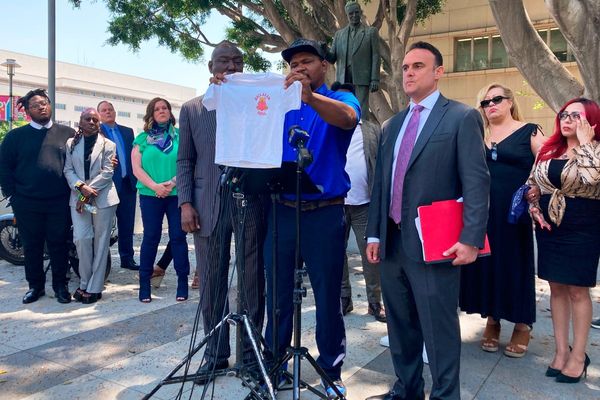President Joe Biden unveiled a $6.9 trillion budget blueprint Thursday that promises to cut projected deficits and safeguard cherished entitlement programs for seniors as he confronts a new Republican-controlled House for the first time in his presidency.
The fiscal 2024 budget request proposes a slew of new spending designed to increase child care, build affordable housing, reduce home energy bills, make college more affordable, and more. But it relies more heavily on tax increases for upper-income households to pay for those programs while trying to tame rising deficits.
The plan calls for imposing a 25 percent minimum tax on the wealthiest 0.01 percent of households, quadrupling a 1 percent surcharge on corporate stock buybacks, restoring the top marginal income tax rate to 39.6 percent, and raising the corporate income tax rate from 21 percent to 28 percent, among other things.
And it promises to extend the solvency of Medicare by a quarter-century by raising Medicare taxes on those making more than $400,000 a year and expanding the authority for Medicare to negotiate prices with drug manufacturers.
While spending would increase by $1.9 trillion over a decade, revenue would increase by $4.7 trillion, for over $2.8 trillion in 10-year deficit reduction. But according to the Office of Management and Budget’s numbers, the budget shortfall would still total more than $17 trillion over the next decade even if Biden’s plans were fully implemented, which seems unlikely.
The deficit would grow from nearly $1.6 trillion this fiscal year to nearly $1.85 trillion next year. It would then gradually decline to $1.5 trillion in fiscal 2027 before inching back up, topping $2 trillion fiscal 2033.
No more ‘disinvestment’
The emphasis on fiscal discipline marks a shift in tone from his first budget proposal, issued two years ago, that offered up a spending spree designed to make up for what administration officials described at the time as a “decade of disinvestment” in domestic programs.
But Biden’s push for tax increases aimed at the wealthy sets the stage for a clash this year with Republican lawmakers who have already made clear their opposition.
“I do not believe raising taxes is the answer,” Speaker Kevin McCarthy, R-Calif., told reporters Wednesday. “I had this conversation with the president personally.”
Cecilia Rouse, outgoing chair of Biden’s Council of Economic Advisers, countered expected GOP criticism that tax increases in the budget would hurt economic growth. She told reporters in a conference call that the 2017 Republican tax cuts that favored upper-income households “really has had no impact that economists have been able to determine on economic growth. It’s been exaggerated.”
And it is not just a fight over tax policy. Another battle will be waged over discretionary spending priorities.
Republicans are pushing for more generous defense spending as concerns grow about a rising China and the war in Ukraine enters its second year.
Biden proposed spending $886.4 billion on defense in the coming fiscal year, a 3.3 percent increase over this year’s level, not counting emergency funding. But nondefense discretionary spending would rise by over 8 percent, to roughly $841 billion.
White House budget director Shalanda Young defended the larger percentage increase for nondefense discretionary spending, saying it is similar to what Congress passed in December in the fiscal 2023 omnibus spending law. “All of our proposals are paid for and we’re doing this in a fiscally responsible manner,” she said in the conference call.
Among the cabinet departments and major agencies, big winners include the EPA, which would see a 19.2 percent base discretionary funding boost. The National Science Foundation’s 18.6 percent boost reflects an effort to fund last year’s law to boost domestic manufacturing and research and development.
Other agencies with substantial proposed increases include the Treasury Department at 15 percent, and the Agriculture and Education departments at roughly 14 percent.
House Republicans have said they want to cut next year’s discretionary spending down to fiscal 2022 levels, a move that would require cutting about 9 percent from current funding levels. But many of them also have said they want to protect defense and veterans programs, a position that would require far deeper cuts to other nondefense programs.
Even before the budget was released, Senate Minority Leader Mitch McConnell, R-Ky., told reporters that Biden’s plan for “massive taxes” and spending would “not see the light of day.”
And the budget battle will unfold as both parties brace for a showdown over raising the statutory debt limit by summer to ensure the Treasury can pay all its bills.
House Republican leaders, who want to tie spending cuts to a debt limit increase, issued a joint statement Thursday faulting Biden for “proposing out of control spending and delaying debt negotiations, following his pattern of shrugging and ignoring when faced with a crisis.”
The White House plan also makes some optimistic assumptions about the economy that could skew its revenue projections if they prove too rosy.
The administration expects last year’s soaring inflation to wane dramatically. The consumer price index would fall from 8.1 percent in calendar year 2022 to 4.3 percent this year and drop to 2.4 percent next year. It would then fall to 2.3 percent in 2025 and remain there through 2033.
Economic output, as measured by gross domestic product, would surge from 0.4 percent in 2023, measured from fourth quarter to fourth quarter, to 2.1 percent next year.
And the average annual interest rate on 10-year Treasury notes would drop from 3.9 percent this year to 3.6 percent next year, even as the Federal Reserve warned this week it may need to raise rates more than anticipated to curb inflation.
Young credited Biden with presiding over $1.7 trillion in deficit reduction during his first two years in office. But she cautioned not to expect such large reductions in the future, now that pandemic relief programs have wound down.
“We would not expect to continue to see large deficit reduction year to year, just as we do not expect to see the rapid economic growth and job creation,” she said in the conference call.
Lindsey McPherson contributed to this report.
The post White House blueprint would raise taxes, boost spending appeared first on Roll Call.







